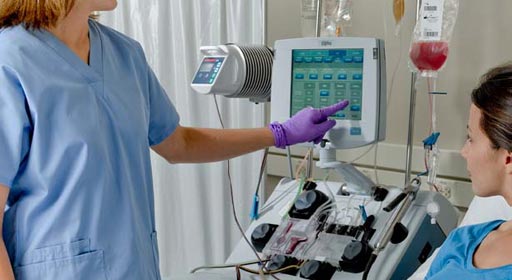Apheresis System with Secondary Devices Evaluated
By LabMedica International staff writers
Posted on 06 Jun 2017
Therapeutic plasma exchange (TPE) reduces the levels of pathological factors circulating in the patient’s plasma and it relieves symptoms or prevents further destruction of the involved organ or system.Posted on 06 Jun 2017
As an alternative to TPE, specific plasma purification methods such as lipoprotein apheresis or immunoadsorption have been developed for selective removal of the purported pathological substances from the separated plasma.

Image: The Spectra Optia apheresis system (Photo courtesy of Terumo BCT).
Scientists at the University Hospital Jena (Germany) examined the last 300 data log files from November 2015 until October 2016. Of these 300 procedures, 149 secondary plasma treatments were conducted in 13 patients, 76 immunoadsorption (IA) and 73 lipoprotein apheresis (LA). Nine patients had IA due to transplantation and autoimmune diseases. Four patients were treated with LA after heart transplantation. Of the procedures, 62% were performed using peripheral venous access, even in patients with a low inlet blood flow.
All patients were treated with the Spectra Optia Apheresis System. An adsorption matrix, Immunosorba, was used for IA, and the Fresenius Medical Care Monet or Evaflux was used for LA. The immunoadsorption (IA) columns need an additional device for secondary plasma processing. Adasorb devices allow adsorption and desorption (regeneration) of the columns. In one session, the device treats up to 10,000 mL of plasma.
A central catheter was required only in 15% cases, and an arteriovenous fistula in 23% of the procedures. Anticoagulation management differed in both procedures. The LA procedures required a higher amount of citrate as they were performed using only citrate. The IA procedures required less citrate because a mixture of citrate and heparin was used. The scientists did not observe clotting or bleeding, regardless of heparin use. Due to strict calcium management, no patient showed signs of hypocalcemia. They found that the targeted substances could be reduced significantly: lipoprotein (a) (Lpa) level by 68%, low-density lipoprotein-cholesterol by 57%, and immunoglobulin G (IgG) from 6.6 to 2.61 g/L.
The authors concluded that the Spectra Optia had a high plasma extraction efficiency, which allows secondary plasma device procedures with peripheral venous access and moderate inlet flow rates. One of the biggest advantages of the Optia is its high plasma removal efficiency. Ideal plasma flow rates for filter or IA columns could be reached faster. The study was published on May 24, 2017, in the International Journal of Clinical Transfusion Medicine.
Related Links
University Hospital Jena













